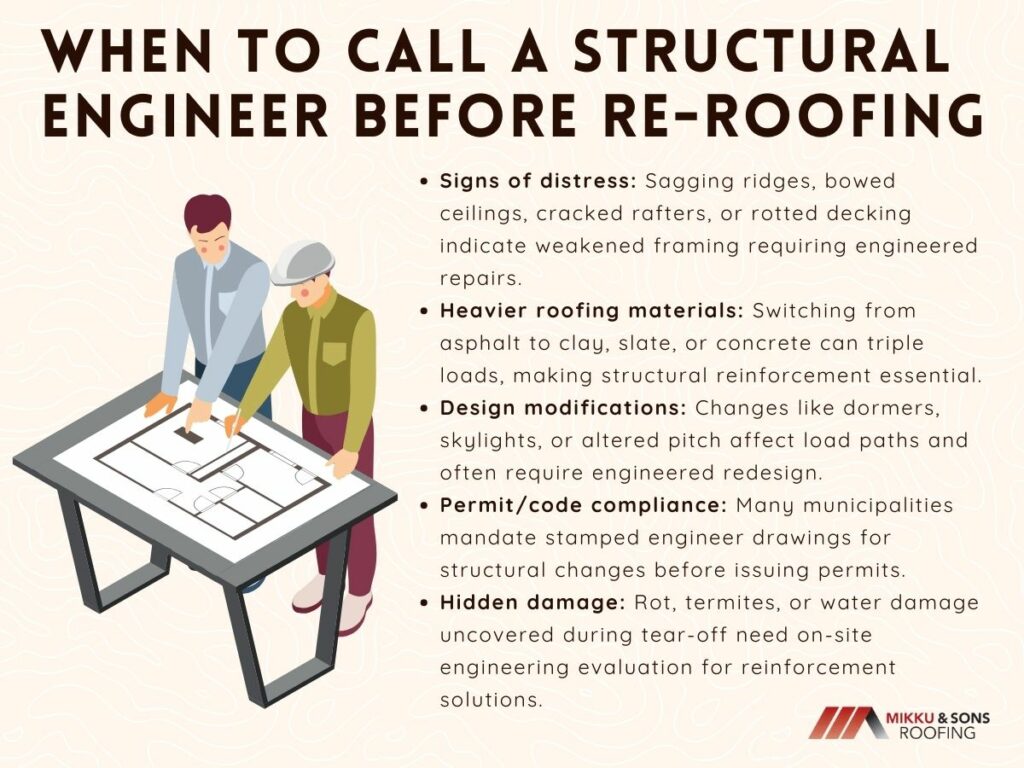

Replacing a roof represents a substantial commitment, both financially and structurally. Homeowners must weigh more than the cost of materials and labor; assessing whether the roof’s underlying structure can safely accommodate new loads proves essential.
Engaging a structural engineer serves as a critical safeguard when conditions raise concern, helping to prevent costly mistakes and preserve long-term integrity. Budgeting for a re‑roofing project involves more than calculating shingles and tear‑off fees.
A structural engineer’s evaluation may range from a modest inspection to a full set of design plans, depending on the complexity.

Replacing a roof often appears to be a routine construction task, yet specific circumstances demand the expertise of a structural engineer. As a fundamental component of a building’s load-bearing system, the roof plays a critical role in overall stability.
| Situation | Why It Matters | What the Engineer Provides |
|---|---|---|
| Visible structural distress (sagging ridge, bowed ceilings, cracked rafters) | Indicates weakened framing that may not support new loads | Inspection, repair design (sister joists, new beams, truss reinforcement) |
| Upgrading to heavier roofing materials (e.g., asphalt → clay tile or slate) | Material weight may exceed original design capacity | Load-bearing analysis, reinforcement plans |
| Modifying roof design (pitch change, dormers, skylights, extensions) | Alters how loads transfer through framing → risk of collapse if miscalculated | Redesign of load paths, engineered drawings |
| Permit/code requirements | Many jurisdictions require stamped engineer drawings for structural changes | Stamped plans to meet building codes |
| Hidden damage uncovered during tear-off | Rot, termites, or long-term leaks weaken unseen framing | On-site evaluation + reinforcement solutions |
Any change to its materials, configuration, or structural condition requires a thorough evaluation to ensure the building remains safe, compliant, and capable of supporting new loads. Bringing in a structural engineer ensures your home meets current building codes, supports intended loads, and remains safe for years to come.
Signs such as sagging ridge lines, bowed ceilings, cracked or split rafters, and soft or spongy roof decking all suggest underlying structural weakness. These issues often stem from long-term water intrusion, prior storm damage, rot, or substandard previous repairs.
A typical roofing contractor may identify surface damage but lacks the qualifications to evaluate or design structural reinforcements. A professional structural engineer inspection assesses the full extent of these concerns and determines whether the existing framework can safely support a new roofing system.
In some cases, this can mean identifying where sistering joists, replacing damaged beams, or reconfiguring trusses is necessary, tasks that must be based on precise calculations and design judgment.
When homeowners opt to switch roofing materials, structural assessment becomes even more critical. Replacing lightweight asphalt shingles with heavier options like slate, clay tile, or concrete can triple the weight load.
While asphalt shingles typically weigh between 200–300 pounds per square (100 sq. ft.), clay tiles can exceed 1,000 pounds per square. These added loads may surpass what the original roof framing was designed to handle, especially in older homes.
Before moving forward with a material upgrade, a structural engineer should perform a load-bearing analysis to confirm whether reinforcement is required. They assess joist spacing, beam dimensions, roof pitch, and snow load implications, then offer engineered solutions if modifications are necessary.
Re-roofing sometimes coincides with more ambitious remodeling, such as changing the roof pitch, adding dormers or skylights, building out roof extensions, or converting a flat roof into a pitched design. These alterations significantly affect how structural loads, such as the weight of the roof itself, live loads like snow, and wind forces, are distributed through the framing system and down to the foundation.
These adjustments can invalidate the assumptions used in the original building’s structural design. A structural engineer’s redesign evaluates the entire load path, ensuring walls, beams, and connections are reinforced or reconfigured where necessary.
For example, cutting into a rafter to add a skylight may seem simple but could compromise the structural integrity of the surrounding area without additional framing support. Building departments in many jurisdictions also require structural drawings stamped by a licensed engineer to approve permits for re-roofing projects that involve design changes.
Many municipalities enforce strict codes when it comes to structural alterations during roofing projects. These regulations often require stamped structural plans from a licensed engineer when altering roof pitch, modifying trusses, or changing roofing material weight.
Failing to meet these requirements may result in stop-work orders, denied permits, or forced reconstruction at the homeowner's expense. Local building codes may also have specific requirements around snow loads, wind uplift resistance, and seismic considerations that must be addressed during a re-roof.
A structural engineer ensures all plans conform to these standards, and their involvement increases the likelihood of swift permit approval.
Long-standing moisture intrusion from a leaking roof may cause rot in the decking, mold behind insulation, or termite infestation in the framing. These problems often go unnoticed until a contractor begins demolition, and at that point, quick decision-making becomes essential.
A structural engineer can quickly assess exposed framing and recommend reinforcements before the new roof is installed. In such cases, relying on a contractor’s judgment alone may lead to underestimating the severity of the issue.
A qualified engineer provides specific, calculated solutions that not only address immediate safety concerns but also ensure the longevity of the new roof. For more insight into this process,
Hiring a structural engineer adds a critical layer of safety and compliance to any re-roofing project, but it also introduces an additional line item to the budget. These costs vary significantly depending on the scope of work, location, and complexity of the structural concerns.
| Service Type | Average Cost Range | What’s Included |
|---|---|---|
| Inspection Only | $300 – $800 (simple); $150 – $1,000+ (depending on scope) | On-site visit, visual inspection, summary/report |
| Full Plans / Design Solutions | $500 – $3,000 (residential); $2,000 – $8,500+ (complex remodels) | Load calculations, engineered drawings, stamped approvals |
| Hourly Billing | $100 – $220/hr (avg. $150/hr) | Consultations, redesigns, review of contractor plans |
| Percentage of Project Cost | 1% – 5% of construction budget | Common in custom builds or major remodels |
The pricing models and what affects those costs help homeowners plan more accurately and avoid unexpected expenses. Some projects may call for a basic inspection, others for a detailed load analysis or full structural drawings.
For basic structural evaluations, often requested when visible damage exists or minor framing issues are suspected, engineers typically charge a flat rate. According to HomeGuide, the average fee for a structural roof inspection ranges from $300 to $800, depending on the size of the property and region.
Smaller inspections with limited scope may cost as little as $150, while more complex assessments with written reports and photos can reach $1,000 or more. These fees generally cover an on-site visit, a visual inspection of accessible areas, and a summary of findings.
For homes with attics or exposed framing, inspections are often more straightforward. However, if intrusive investigation is needed, such as cutting into walls or decking, expect additional labor costs.
When structural changes are planned or significant damage is found, engineers may be required to produce full drawing sets, calculations, and design solutions. This scenario arises frequently in re-roofing projects involving material upgrades, roof pitch changes, or additions.
Costs for these services typically range from $500 to $3,000 for residential projects, depending on complexity and required documentation. More extensive scope, such as reconfiguring roof framing, designing support beams, or overseeing large remodels, can push costs higher.
Angi reports full-service structural engineering projects may cost $2,000 to $8,500, with more elaborate custom homes or challenging renovations commanding even greater fees. Engineers often include site visits, calculation sheets, structural blueprints, and stamped approval documents in these packages.
Some engineers work on an hourly basis, especially for consultations, redesigns, or partial reviews of contractor plans. Typical hourly rates range from $100 to $220 per hour, though in high-cost areas or for senior engineers, this can rise to $250 or more per hour.
HomeGuide cites a national average of $150 per hour for structural consulting services. For large-scale projects involving collaboration with architects and contractors, engineers may charge based on a percentage of the overall construction cost, generally between 1% and 5% for residential jobs.
This model is more common in custom home builds or extensive remodels where the engineer contributes to design coordination from start to finish. To minimize costs, some homeowners choose to limit the engineer’s role to specific tasks, such as evaluating load-bearing capacity or providing a stamped letter for permitting.
Bringing in a structural engineer adds another cost to your roofing project, but for many homeowners, this upfront investment pays dividends in both the short and long term. Structural failures, denied permits, and hidden damage can lead to far greater financial losses than the cost of a proper evaluation.
In scenarios involving material changes, visible distress, or code-sensitive renovations, a structural engineer provides clarity, confidence, and legal protection that no contractor or roofer alone can guarantee.
One of the most compelling reasons to hire a structural engineer is the ability to detect and address unseen vulnerabilities before re-roofing begins. Engineers evaluate critical factors like rafter deflection, roof pitch limitations, framing spacing, and long-term load distribution.
| Roofing Material | Approx. Weight per Square (100 sq. ft.) | Structural Impact |
|---|---|---|
| Asphalt Shingles | 200 – 300 lbs | Standard load, usually safe on existing framing |
| Wood Shakes | 300 – 400 lbs | Slightly heavier; may need reinforcement on older homes |
| Metal Roofing | 250 – 400 lbs | Moderate; depends on profile/gauge |
| Clay Tile | 900 – 1,100+ lbs | Heavy; often requires reinforcement |
| Slate | 800 – 1,500+ lbs | Very heavy; almost always requires structural evaluation |
These calculations are essential when switching to heavier materials or adding features like solar panels or skylights. Overlooking these details can lead to roof sagging, accelerated wear, water pooling, or worse, partial collapse. Repairs after the fact are always more expensive than doing it right the first time.
A professional inspection or engineered design ensures that re-roofing doesn’t compromise the structure below.
In many municipalities, building permit offices require stamped drawings or reports from a licensed engineer before approving projects that alter load-bearing systems. This includes re-framing portions of a roof or switching materials.
If a homeowner proceeds without this documentation, they may face stop-work orders, inspection failures, or costly demolition to meet retroactive compliance. In addition, insurance companies increasingly rely on structural engineer evaluations to confirm storm damage, especially in areas prone to wind, hail, or hurricane conditions.
An independent assessment provides documentation to support claims and often helps secure a faster payout. Without it, insurers may question whether structural damage predated the event.
Beyond immediate savings or approvals, a structural engineer’s involvement contributes to the long-term safety and value of your home. Buyers are more likely to purchase homes with proper documentation and engineered designs, especially in areas with a history of natural disasters or structural issues.
Engineers provide homeowners with peace of mind, knowing the roof isn’t just new but supported by sound framing and compliant with current standards. This is particularly important in older homes where building practices have changed significantly over time.
In many cases, the modest cost of engineering services prevents thousands of dollars in future repairs, redesigns, or legal complications.
Engaging a structural engineer during re-roofing isn’t always mandatory, but it’s often prudent. When the underlying structure shows signs of distress, load changes are expected, or permits demand it, the specialist’s assessment becomes essential.
Cost typically ranges from a few hundred dollars for a simple inspection to several thousand for full structural redesign, with billing models that may suit your project’s scale and complexity. Ultimately, the value lies in ensuring safety, complying with code, and preserving long-term stability.
Prioritizing structural due diligence protects your investment, therefore giving you confidence that your new roof rests on a foundation that’s both sound and secure. When planning for the full project, including this crucial step offers a more accurate picture of the total price tag.
